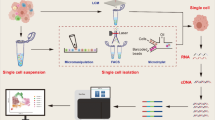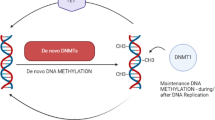Abstract
Molecular studies of many types of cancer have revealed that clinically evident tumours carry multiple genetic and epigenetic abnormalities, including DNA sequence alterations, chromosome copy number changes and aberrant promoter hypermethylation. Together, these aberrant changes result in the activation of oncogenes and inactivation of tumour-suppressor genes (TSG). In many cases these abnormalities can be found in premalignant lesions and even in histological normal adjacent cells. Many tumour types are difficult to detect early and are frequently resistant to available chemotherapy and radiotherapy. Therefore, the early detection, chemoprevention and the design of new therapeutic strategies based on the increased understanding of cancer molecular changes are one of the great challenges nowadays. Insertions of a methyl group at the fifth carbon of cytosines within the dinucleotide 5′-CpG-3′ is the best studied epigenetic mechanism. DNA methylation acts together with others mechanisms like histone modification, chromatin remodelling and microRNAs to mould the DNA structure according to the functional state required. The aberrant methylation of the CpG islands located at the promoter region of specific genes is a common and early event involved in cancer development. Thus, hypermethylated DNA sequences from tumours are one of the most promising markers for early detection screenings as well as tumour classification and chemotherapy response in many types of cancer.
Similar content being viewed by others
References
Parkin DM, Bray F, Ferlay J, Pisani P (2001) Estimating the world cancer burden: Globocan 2000. Int J Cancer 94:153–156
Kagan J, Srivastava S, Barker PE et al (2007) Towards clinical application of methylated DNA sequences as cancer biomarkers: a joint NCI’s EDRN and NIST workshop on standards, methods, assays, reagents and tools. Cancer Res 67:4545–4549
Santi DV, Garrett CE, Barr PJ (1983) On the mechanism of inhibition of DNA-cytosine methyltransferases by cytosine analogs. Cell 33:9–10
Bestor TH, Verdine GL (1994) DNA methyltransferases. Curr Opin Cell Biol 6:380–389
Bestor TH (2000) The DNA methyltransferases of mammals. Hum Mol Genet 9:2395–2402
Hermann A, Gowher H, Jeltsch A (2004) Biochemistry and biology of mammalian DNA methyltransferases. Cell Mol Life Sci 61:2571–2587
Goll MG, Kirpekar F, Maggert KA et al (2006) Methylation of tRNA Asp by the DNA methyltransferase homolog Dnmt2. Science 311:395–398
Chan MF, van Amerongen R, Nijjar T et al (2001) Reduced rates of gene loss, gene silencing, and gene mutation in Dnmt1-deficient embryonic stem cells. Mol Cell Biol 21:7587–7600
Sved J, Bird A (1990) The expected equilibrium of the CpG dinucleotide in vertebrate genomes under a mutation model. Proc Natl Acad Sci U S A 87:4692–4696
Bird A (2002) DNA methylation patterns and epigenetic memory. Genes Dev 16:6–21
Takai D, Jones PA (2002) Comprehensive analysis of CpG islands in human chromosomes 21 and 22. Proc Natl Acad Sci U S A 99:3740–3745
Issa JP, Ottaviano YL, Celano P et al (1994) Methylation of the oestrogen receptor CpG island links ageing and neoplasia in human colon. Nat Genet 7:536–540
Baylin SB, Herman JG (2000) DNA hypermethylation in tumorigenesis: epigenetics joins genetics. Trends Genet 16:168–174
Jones PA, Laird PW (1999) Cancer epigenetics comes of age. Nat Genet 21:163–167
Herman JG, Baylin SB (2003) Gene silencing in cancer in association with promoter hypermethylation. N Engl J Med 349:2042–2054
Shen L, Ahuja N, Shen Y et al (2002) DNA methylation and environmental exposures in human hepatocellular carcinoma. J Natl Cancer Inst 94:755–761
Issa JP, Baylin SB, Belinsky SA (1996) Methylation of the estrogen receptor CpG island in lung tumors is related to the specific type of carcinogen exposure. Cancer Res 56:3655–3658
Kim DH, Nelson HH, Wiencke JK et al (2001) p16(INK4a) and histology-specific methylation of CpG islands by exposure to tobacco smoke in non-small cell lung cancer. Cancer Res 61: 3419–3424
Koul S, McKiernan JM, Narayan G et al (2004) Role of promoter hypermethylation in Cisplatin treatment response of male germ cell tumors. Mol Cancer 3:16
Baylin SB, Herman JG, Graff JR et al (1998) Alterations in DNA methylation: a fundamental aspect of neoplasia. Adv Cancer Res 72:141–196
Gaudet F, Hodgson JG, Eden A et al (2003) Induction of tumors in mice by genomic hypomethylation. Science 300:489–492
Frommer M, McDonald LE, Millar DS et al (1992) A genomic sequencing protocol that yields a positive display of 5-methylcytosine residues in individual DNA strands. Proc Natl Acad Sci U S A 89:1827–1831
Herman JG, Graff JR, Myohanen S et al (1996) Methylation-specific PCR: a novel PCR assay for methylation status of CpG islands. Proc Natl Acad Sci U S A 93:9821–9826
Eads CA, Danenberg KD, Kawakami K et al (2000) MethyLight: a high-throughput assay to measure DNA methylation. Nucleic Acids Res 28:E32
Fraga MF, Esteller M (2002) DNA methylation: a profile of methods and applications. Biotechniques 33:632–649
Ibanez de Caceres I, Battagli C, Esteller M et al (2004) Tumor cell-specific BRCA1 and RASSF1A hypermethylation in serum, plasma, and peritoneal fluid from ovarian cancer patients. Cancer Res 64:6476–6481
Egger G, Liang G, Aparicio A, Jones PA (2004) Epigenetics in human disease and prospects for epigenetic therapy. Nature 429:457–463
Liang G, Gonzales FA, Jones PA et al (2002) Analysis of gene induction in human fibroblasts and bladder cancer cells exposed to the methylation inhibitor 5-aza-2′-deoxycytidine. Cancer Res 62:961–966
Suzuki H, Gabrielson E, Chen W et al (2002) A genomic screen for genes upregulated by demethylation and histone deacetylase inhibition in human colorectal cancer. Nat Genet 31:141–149
Yamashita K, Upadhyay S, Osada M et al (2002) Pharmacologic unmasking of epigenetically silenced tumor suppressor genes in esophageal squamous cell carcinoma. Cancer Cell 2:485–495
Ibanez de Caceres I, Dulaimi E, Hoffman AM et al (2006) Identification of novel target genes by an epigenetic reactivation screen of renal cancer. Cancer Res 66:5021–5028
Sato N, Fukushima N, Maitra A et al (2003) Discovery of novel targets for aberrant methylation in pancreatic carcinoma using high-throughput microarrays. Cancer Res 63:3735–3742
Tokumaru Y, Yamashita K, Osada M et al (2004) Inverse correlation between cyclin Al hypermethylation and p53 mutation in head and neck cancer identified by reversal of epigenetic silencing. Cancer Res 64:5982–5987
Lodygin D, Epanchintsev A, Menssen A et al (2005) Functional epigenomics identifies genes frequently silenced in prostate cancer. Cancer Res 65:4218–4227
Shames DS, Girard L, Gao B et al (2006) A genome-wide screen for promoter methylation in lung cancer identifies novel methylation markers for multiple malignancies. PLoS Med 3:e486
Jahr S, Hentze H, Englisch S et al (2001) DNA fragments in the blood plasma of cancer patients: quantitations and evidence for their origin from apoptotic and necrotic cells. Cancer Res 61:1659–1665
Evron E, Dooley WC, Umbricht CB et al (2001) Detection of breast cancer cells in ductal lavage fluid by methylation-specific PCR. Lancet 357:1335–1336
Dulaimi E, Hillinck J, Ibanez de Caceres I et al (2004) Tumor suppressor gene promoter hypermethylation in serum of breast cancer patients. Clin Cancer Res 10:6189–6193
Cairns P, Esteller M, Herman JG et al (2001) Molecular detection of prostate cancer in urine by GSTP1 hypermethylation. Clin Cancer Res 7:2727–2730
Henrique R, Jeronimo C (2004) Molecular detection of prostate cancer: a role for GSTP1 hypermethylation. Eur Urol 46:660–669
Jeronimo C, Henrique R, Hoque MO et al (2004) Quantitative RARbeta2 hypermethylation: a promising prostate cancer marker. Clin Cancer Res 10:4010–4014
Rosenbaum E, Hoque MO, Cohen Y et al (2005) Promoter hypermethylation as an independent prognostic factor for relapse in patients with prostate cancer following radical prostatectomy. Clin Cancer Res 11:8321–8325
Palmisano WA, Divine KK, Saccomanno G et al (2000) Predicting lung cancer by detecting aberrant promoter methylation in sputum. Cancer Res 60:5954–5958
Chang YS, Kong G, Sun S et al (2002) Clinical significance of insulin-like growth factor-binding protein-3 expression in stage I non-small cell lung cancer. Clin Cancer Res 8:3796–3802
Chang YS, Wang L, Liu D et al (2002) Correlation between insulin-like growth factor-binding protein-3 promoter methylation and prognosis of patients with stage I non-small cell lung cancer. Clin Cancer Res 8:3669–3675
Battagli C, Uzzo RG, Dulaimi E et al (2003) Promoter hypermethylation of tumor suppressor genes in urine from kidney cancer patients. Cancer Res 63:8695–8699
Hoque MO, Begum S, Topaloglu O et al (2004) Quantitative detection of promoter hypermethylation of multiple genes in the tumor, urine, and serum DNA of patients with renal cancer. Cancer Res 64:5511–5517
Dulaimi E, Uzzo RG, Greenberg RE et al (2004) Detection of bladder cancer in urine by a tumor suppressor gene hypermethylation panel. Clin Cancer Res 10:1887–1893
Siu LL, Chan JK, Wong KF et al (2003) Aberrant promoter CpG methylation as a molecular marker for disease monitoring in natural killer cell lymphomas. Br J Haematol 122:70–77
Chen WD, Han ZJ, Skoletsky J et al (2005) Detection in fecal DNA of colon cancer-specific methylation of the nonexpressed vimentin gene. J Natl Cancer Inst 97:1124–1132
Esteller M, Garcia-Foncillas J, Andion E et al (2000) Inactivation of the DNA-repair gene MGMT and the clinical response of gliomas to alkylating agents. N Engl J Med 343:1350–1354
Di Nicolantonio F, Mercer SJ, Knight LA et al (2005) Cancer cell adaptation to chemotherapy. BMC Cancer 5:78
Glasspool RM, Teodoridis JM, Brown R (2006) Epigenetics as a mechanism driving polygenic clinical drug resistance. Br J Cancer 94:1087–1092
Chavez-Blanco A, Perez-Plasencia C, Perez-Cardenas E et al (2006) Antineoplastic effects of the DNA methylation inhibitor hydralazine and the histone deacetylase inhibitor valproic acid in cancer cell lines. Cancer Cell Int 6:2
Author information
Authors and Affiliations
Corresponding author
Additional information
Supported by an unrestricted educational grant from Roche Farma S.A.
Rights and permissions
About this article
Cite this article
Ibáñez de Cáceres, I., Cairns, P. Methylated DNA sequences for early cancer detection, molecular classification and chemotherapy response prediction. Clin Transl Oncol 9, 429–437 (2007). https://doi.org/10.1007/s12094-007-0081-9
Published:
Issue Date:
DOI: https://doi.org/10.1007/s12094-007-0081-9




